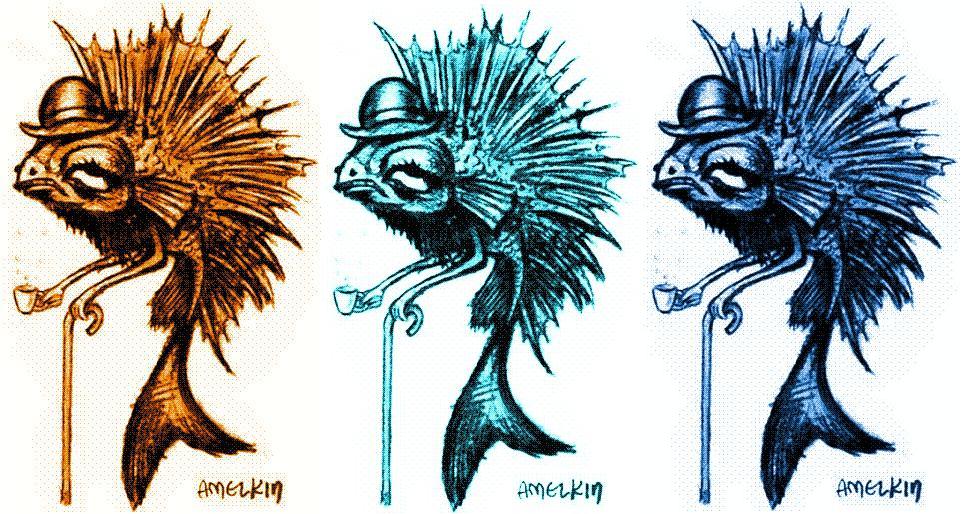+ ещё 141 неизвестный

| 02.06.2015, 10:17 | Живопись, графика, рисунок » Иллюстрация | ||||||||||||||
|
| ||||||||||||||
|
| |||||||||||||||
|
Aliens Tilapia sapiens from Natron II and the Origin of MS 408
из серий портреты, животные, юмор, Logo, Pop-Surrealismus, mood, Biozentrismusstil, © Tilapia sapiensавтор: Александр Амелькин | |||||||||||||||
|
"Aliens Tilapia sapiens from Natron II and the Origin of MS 408"
Alexander A. Amelkin I think, that MS 408 was written in Tyrol (in Innsbruck or in Meran) in the language of the Avars by a descendant of the Counts of Andechs at the Court of Frederick IV, Duke of Further Austria. The town of Innsbruck was founded in 1234 by the Counts of Andechs. And the noble family of Andechs probably came from Karantania and knew the ancient language of the Avars. I have invented an ancient coin of the Counts of Andechs, which can probably exist in a similar form somewhere in Andechs, Munich, Innsbruck or Meran. I will definitely find in these areas the inscriptions in this ancient language, that was later used in MS 408. Probably the author of MS 408 used an anscient cursive Mongolian script (Hudum Mongol bichig) but in horizontal direction and with some changes. [4] The town of Meran was a capital of Tyrol till 1420, where the first swallowtail merlons (swallow-tail or ghibelline crenellations) in the history of medieval castle architecture were introduced (look at rosettes page of MS 408). In 1420 Frederick IV, Duke of Austria moved the Tyrolean court to Innsbruck. The author of MS 408 created his manuscript with the help of AstroTilapias (the alien fishes from "Natron II", a moon of epsilon Eridani b) using the language of the Avars. Later Johann Bayer (1572 — 1625), a German lawyer and uranographer, draw a picture of this flying astro-fish in his star atlas Uranometria Omnium Asterismorum… I made some reconstructions of AstroTilapias from space… The Andechs and later the Habsburgs knew and understood this language. And some sources of their power they found in knowledges of AstroTilapias… One of the modern investigators of Voynich Manuscript Mr Rene Zandbergen writes the following [3]. "A modern historian of botany, Sergio Toresella [1], identifies the style of the herbal drawings of the Voynich MS and the style of the script with Northern Italy, around 1460. He recognises a humanist hand in the script of the MS. A similar opinion was expressed by J. Parez, archivist of the Strahov library in Prague, when I met him in 2004. He commented that the MS pages show an Italian style and that the scribe was clearly expert in writing the script of the Voynich MS. He also indicated that the last page of the MS, with its mixture of German, Latin and "Voynichese" text, looks more Central European, and is from well before 1550. With predominantly Italian and also some German influences, the best guess one can make at this time is that of an 'Alpine' origin of the MS. One region where both influences could be expected would be Tyrol, nowadays composed of the regions Tirol, Sued-Tirol and Trentino — Alto Adige, divided over Austria and Italy, but this is just a speculation. It is however of interest that this region includes the warm baths of Vetriolo, with arsenic, cuprous and ferrous minerals, which were already known in the late middle ages, and whose waters may have appeared relatively green. Would these be the baths represented in the biological section of the MS [2]?" AstroTilapia (Alcolapia alcalica, Natron tilapia, Tilapia sapiens) is a genus of fishes in the Cichlidae family. Their native range is largely restricted to the hypersaline, warm Lake Natron in Kenya and Tanzania, but has also been introduced to Lake Nakuru [5]. AstroTilapia inhabits waters rich in sodium and chlorides and temperature ranges between 1–60 Grad Celsius [6]. Liquid water oceans exist on several objects in our solar system. These include Earth with its surface oceans, and Jupiter’s moons Europa, Ganymede and Callisto, and Saturn’s moons Titan and Enceladus where the oceans are below the surface. Saturn's moon Enceladus joins Jupiter's moon Europa as one of the solar system's most promising havens for extraterrestrial life [7]. Hydrothermal activity on Europa and Enceladus resembles that seen in Lake Natron on Earth. AstroTilapias came from epsilon Eridani b and founded 2 colonies on Europa and Enceladus. Later Lake Natron and Lake Nakuru on the Earh were colonized. NOTES 1. Toresella, Sergio (1995). "Gli erbari degli alchmisti", in: L. Saginati, Arte farmaceutica e piante medicinali; erbari, vasi, strumenti e testi dalle raccolte liguri, 1995 2. Suggestion by Dr. Alexander Sperl 3. Rene Zandbergen (2015). ( 4. Wikipedia: Mongolian script ( 5. Wikipedia: Alcolapia ( 6. Bayona, J.D.R. (2006). "Alcolapia alcalica". IUCN Red List of Threatened Species. Version 2013.1. International Union for Conservation of Nature. Retrieved 3 October 2013. 7. Andrew Coates (2015). "Warm Oceans on Saturn’s Moon Enceladus Could Harbor Life", Discover, March 12, 2015, 12:16 pm | |||||||||||||||
Автор разрешил комментировать свои работы только пользователям сайта

